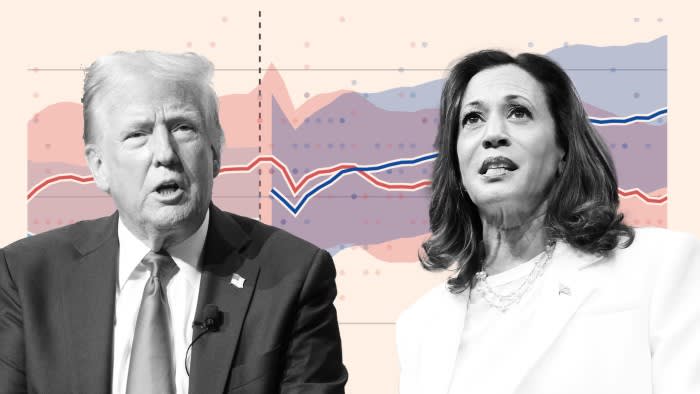Unlock the US Election Countdown newsletter for free
The stories that matter on money and politics in the race for the White House
With 60 days until US voters elect their next president, the race between Kamala Harris and Donald Trump is in effect tied.
Less than two months after President Joe Biden withdrew from the race, the polls have flipped in favour of Democratic candidate Harris but a Financial Times analysis shows the race is exceptionally close, reviving memories of the 2020 election, when Biden narrowly beat Trump, a Republican, in the crucial swing states.
Vice-president Harris has some advantages over Trump: his disapproval rating is higher and her campaign is spending far more on ads.
Still, any polling lead Harris holds in battleground states is well within the margin of error.
What are the polls saying right now?
Harris is now leading Trump by 48.8 per cent to 45.2 per cent nationally, according to the FT’s election polling tracker.
Unfortunately for Harris, US presidential elections are ultimately decided by the Electoral College in a winner-take-all system that gives outsize influence to a small number of battleground states.
Each of the 50 states has a number of votes in the Electoral College equal to the sum of its senators and representatives in Congress. The capital, Washington DC, which has no representatives or senators, has three votes. The candidate who secures at least 270 of the 538 Electoral College votes becomes president.
Trump and Harris are fighting over seven crucial “swing states” — Pennsylvania, Wisconsin, Michigan, Nevada, Arizona, Georgia and North Carolina — which control 93 Electoral College votes.
Harris has the advantage in Wisconsin and Michigan, while Trump has the edge in Arizona and North Carolina, according to the FT’s poll tracker. But their lead in any swing state is below 2 per cent.
The race could very well be decided in Pennsylvania and Nevada, where Harris respectively has a 0.4 per cent and 0.9 per cent margin over Trump, and Georgia, where Trump has a 0.3 per cent margin over the vice-president — leads that are so tiny as to make the outcome impossible to call.
What are the top issues for voters?
The number one priority for voters remains the economy. Polls in battleground states show Trump leading Harris on the issue.
But last month an FT-Michigan Ross poll found 42 per cent of voters nationwide trusted Harris with the economy, compared with 41 per cent for Trump, the first time the monthly survey showed a Democratic candidate leading on the issue since it began tracking voter sentiment nearly a year ago.
Immigration is another top concern for voters, benefiting Trump. In Arizona, a state on the southern border with Mexico, immigration is the second most important issue after the economy for those over 65, according to a CNN poll.
However, Harris benefits from support on abortion rights, which have become the top issue for women under 45, according to a New York Times poll of voters in battleground states, after conservative Supreme Court justices overturned the constitutional right to the procedure.
Who has raised more money and how is it being spent?
Harris has raised more than $540mn since her candidacy was announced in July. Her campaign ended that month with $220mn in cash on hand, while Trump had $151mn, according to an FT analysis of the latest federal filings.
Trump has also spent a significant sum of his smaller war chest — more than $85mn — on legal fees since the beginning of 2023, as he fights off several criminal cases.
The two campaigns and groups supporting the candidates have spent a significant amount on advertising, booking $527mn worth of ads to air between September 2 and election day on November 5 — $340mn for Harris and $187mn for Trump — according to the latest AdImpact data.
Of this $120mn worth of ads has been booked by the Harris campaign, compared to $60mn by the Trump campaign.
Hundreds of millions of dollars of ad funding has also come from super political action committees, which have no limits on the size of individual donations. Future Forward, a pro-Harris super Pac, or allied group, has booked more than $170mn in ads targeting the seven “swing” states and a Nebraska district’s single electoral vote.
A trio of pro-Trump super Pacs — Make America Great Again Inc, Preserve America and Right for America — have booked more than $124mn in ads.
These amounts are expected to increase as the candidates and the groups supporting them raise and spend more cash in the final sprint to election day.






